In my research developing a tour of 19th century writer and poet, Lydia Sigourney of Hartford, Connecticut, I discovered the creative expressions by women, “everyday women who passed their lives in relative obscurity, raising children, running farms or homes and devoting themselves to ‘useful work.” Self-expressions that reveal the inner lives of women through the arts of needle pictures, quilts and as illustrated in this blog post the sampler. The handiwork, is an ornamentation expressed in vivid detail, offering us an insightful look to the composite life story of the anonymous woman. I am especially intrigued because she is me, a contributor to the beauty of things though the acknowledgment is obscured in the context of hierarchy of the visual arts.

Susan E. Conklin, Maker
Image Credit: Wadsworth Atheneum
At the Wadsworth Atheneum Ms Susan Conklin, she was eleven, created a sampler depicting the residence of Ithiel Town, featuring the home of the famous 19th century Connecticut architect. It illustrates her knowledge of design of the classically inspired house and received attention in a January 1839 article from The Ladies Companion and included Susan’s work.
Samplers were stitched decorative motifs that “embodied and codified the elements of a virtuous life: literacy, piety, and needle wisdom. They were a way to both beautify the home and instill habits of usefulness.” Susan Conklin’s sampler amplifies her “elegant accomplishment” and reveals an interior part of her life. I connect with her and other “anonymous” women to fulfill a deeper desire to create and to engage in the aesthetics within a life of family obligations and marital expectations. In my upbringing, in the latter half of the 20th century, I relate and feel an alliance towards the Early American woman who, like me, lived within strict gender roles. Their work, like the Sampler, reveals the interior of the individual woman and her deep inner desire to create.
Learn more about Early American women and the arts in Myra Banks, “Anonymous Was A Woman,” and the The Wadsworth Atheneum American Decorative collection. https://www.thewadsworth.org/
